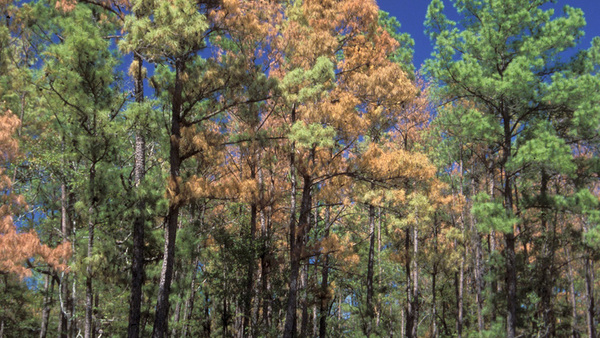
One of the prevalent garden pests in the Mid-Atlantic is hemlock woolly adelgid (or HWA, as it is often abbreviated). Native to Asia, hemlock woolly adelgid (Adelges tsugae) can be found feeding on any North American hemlock (Tsuga spp. and cvs., Zones 3–7). This insect is a nuisance wherever species of hemlocks reside, but the damage is most severe on Eastern hemlock (Tsuga canadensis, Zones 3–7) and Carolina hemlock (T. caroliniana, Zones 6–7), leading to death if left untreated.
Hemlock woolly adelgid life cycle
While HWA is present in the Pacific Northwest, the Midwest, and the upper Southeast, it is by far most prevalent in the Northeast and Mid-Atlantic. In order to protect our hemlocks, it is helpful to understand the life cycle of HWA. All HWA are female, which develop asexually. The first stage of the life cycle starts with the egg. Eggs are found in the cottony masses on trees in the spring. When the eggs hatch, the nymphs (or crawlers) emerge to find new growth on the tree and begin feeding on the base of the needles until they mature to adults. According to Rutgers University Cooperative Extension, in the Mid-Atlantic region the crawlers enter a hibernation stage at the end of the summer and recommence feeding in the fall. As the nymphs enter adulthood in the fall, they begin forming the woolly, waxy substance around their bodies that is the key feature gardeners use to identify HWA.
Once gardeners understand the life cycle of the HWA, the infestation can be treated. The key to treating HWA is to pay close attention once the unmistakable, cottony white mass appears on the hemlock. Once the crawlers hatch from the eggs found in these spots, they will begin feeding while unprotected on the base of new growth for several months. This is the optimal time to treat an infected tree.

Treatment
Organic treatments such as horticultural oil and insecticidal soaps are effective. Researchers have found that a 1% solution of horticultural oil applied from August to September is 100% effective. However, the efficacy of this treatment depends on the proper application. This means complete coverage of the foliage is necessary in order to reach the underside of the branches on the entire tree. If any of the insects are missed, the pests may survive and continue to infest the hemlock.
Another method, preferred by Cornell University, is the use of systemic insecticides. These types of pesticides are applied to the soil at the base of the tree. The pesticide available to homeowners is in the form of a soil drench containing the active ingredient imidacloprid. Any other formulation must be applied by those with a pesticide applicator license. The solution is applied to the soil and ultimately taken up through the tree’s vascular system. Keep in mind that this method is not organic and may have some residual environmental effects; however, it is the most effective treatment.
Lady beetles (like ladybugs) are a natural predator of HWA. One species of lady beetle that’s particularly effective at eating HWA is the black lady beetle (Sasaiiscymnus tsugae). This lady beetle has been imported by scientists from Japan and released into the environment to control HWA. While this is not going to eradicate HWA, it can help limit the spread. Black lady beetles are even available to buy commercially; however, you need a federal permit to release them.

Prevention
HWA is sometimes inevitable, but good cultural practices can help control infestations. Follow these guidelines for prevention:
- Refrain from using birdfeeders near your hemlocks. If there is a woolly egg mass present, it can stick to birds or squirrels and spread to other areas of the tree or other trees.
- Do not fertilize your hemlock. Research has shown that fertilization actually increases the number of eggs produced by HWA.
- Plant different species of hemlock. Western hemlock (T. heterophylla, Zones 6–8) is more resistant to HWA. Chinese hemlock (T. chinensis, Zones 5–9) also has shown excellent resistance to HWA and is even hardier.
Although HWA has ravaged Eastern and Carolina hemlocks, there is good news. The scientists at the U.S. Arboretum have introduced an adelgid-resistant hybrid, crossing a Chinese hemlock and Carolina hemlock. The new hemlock was patented in February 2021 and, hopefully, will be in production soon.
One last note: While it primarily affects hemlocks, secondary hosts of HWA are spruce trees (Picea spp. and cvs., Zones 2–8). Keep an eye on your spruce trees, and treat them accordingly.
—Michele Christiano has worked in public gardens for most of her career. She lives in southern Pennsylvania and currently works as an estate gardener maintaining a private garden designed by Piet Oudolf.
Fine Gardening Recommended Products

The Nature of Oaks: The Rich Ecology of Our Most Essential Native Trees
Fine Gardening receives a commission for items purchased through links on this site, including Amazon Associates and other affiliate advertising programs.

ARS Telescoping Long Reach Pruner
Fine Gardening receives a commission for items purchased through links on this site, including Amazon Associates and other affiliate advertising programs.

A.M. Leonard Deluxe Soil Knife & Leather Sheath Combo
Fine Gardening receives a commission for items purchased through links on this site, including Amazon Associates and other affiliate advertising programs.



















Comments
Log in or create an account to post a comment.
Sign up Log in